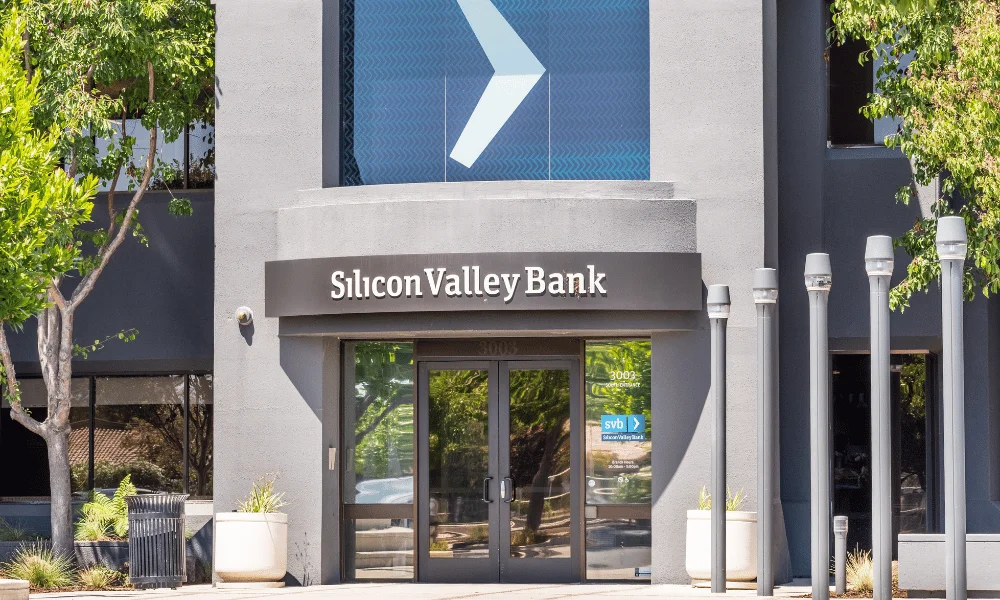
Key points
- The failure of Silicon Valley Bank (SVB) was a classic bank run that exposed a failure of risk management.
- Long duration bonds in the bank’s portfolio suffered from rapidly rising interest rates at the same time that deposits declined for the bank’s heavily concentrated venture/start-up client base.
- Signature Bank was also closed Sunday, and regulators stepped in to backstop all deposits at both banks and offer a new bank lending facility to stave off further contagion.
The First Bank Run Conducted on iPhone
The basic story is the same as the ones from the Great Depression: when everyone piles into the bank demanding their money right now, the bank fails. When was the last time you watched “It’s a Wonderful Life”? Remember poor George Bailey (memorably played by Jimmy Stewart)? He was trying to leave town on his honeymoon, for goodness’ sakes, and had to stop, go back to the bank, and talk the townspeople out of withdrawing all their money and putting the bank under.
Friday morning Silicon Valley Bank (SVB), the premier bank in the world of venture capital and private equity, experienced just such a run and result, although without the drama of mobs jammed into bank lobbies screaming at bank presidents. It was mostly online this time, as a Wall Street Journal article describes.1
The quick summary is that SVB lost money investing in long duration bonds as their depositors withdrew a lot of their cash deposits (they had to fund their startup companies as venture funding dried up in 2022). Suddenly SVB was reporting losses and struggling to pay depositors, and the panic began. It took less than two days.
What the Heck Just Happened Here?
Banks are in the business of taking deposits and lending that money to people and businesses. They are supposed to earn more lending than they pay for the deposits, thus earning a profit. They also have to manage risk; that is critical. A huge risk is that they lend money, e.g., for home mortgages, for long commitments, but deposits are very short-term. George Bailey could not get all the farmers to repay their loans right away so he could pay the depositors–that quickly became a liquidity crisis.
There are two risks here, duration and liquidity. Interest rates paid on deposits adjust very quickly, but longer-term loans or bonds have rates that do not adjust quickly. When rates rise, you may have to pay more than you earn, losing money. Secondly, deposits can leave quickly, but your investments may be less liquid.
Credit risk was not an issue here as it was in the financial crisis of 2007-09 when it played a huge role in the downfall of many hedge funds and banks.
What happened here was a catastrophic failure of risk management. Perhaps it is not surprising, in light of recent events, to know that SVB left the position of Chief Risk Officer unfilled for eight months last year!2
As outlined and supported by data in a JP Morgan article, SVB was unique in the extent to which they had:
- Very high-risk deposits – mom and pop leave their deposits for a long time, but start-ups often burn through cash rapidly. SVP had a huge portion of deposits from companies like that.
- Very low loan-to-deposit ratio. They received huge inflows of cash and could not loan it out fast enough. So, they bought long duration Treasuries and mortgages, taking on massive duration risk when rates were extremely low, much more than other banks did.2
SVB reached for yield by taking on a lot of duration risk funded by very short-term deposits. They added to their woes by failing to do any effective interest rate risk hedging, and they failed to see the Fed announcing a series of interest rate increases that would lead directly to their demise. The value of their bonds fell along with deposits. And in the end, they failed to sell equity to recapitalize when they had the chance.
This will be a business school case for the ages. When you look up “failure of risk control” in a business dictionary, SVB will be right there on the walk of shame.
So, What Does This Mean to Us? Should We Be Worried?
Well, that is not a simple question, and I also recognize that by the time you read this you will know a lot more than I do right now. But there are a few things to consider:
- The FDIC insures deposits up to $250,000. People and businesses with less than that amount at SVB or any other bank are covered by that insurance and not at risk.
– If you personally have more than $250,000 at any bank you might want to consider moving it. – But remember this doesn’t include mutual funds or money market funds; those are separate and not at risk. - SVB appears to have more assets than liabilities; it may be the case that there are no or only small losses to depositors, i.e., to all the small businesses dependent on SVB’s banking services.
- In the short run there are likely to be disruptions. A payroll company like Rippling using SVB may not meet payrolls on time. Etsy is having issues with online commerce.
- There could be delays in getting money to depositors. For a small startup that could be a big issue.
- Another bank, Signature Bank (widely used for cryptocurrency), was shuttered by regulators Sunday. Other banks like First Republic have had substantial stock declines and deposit outflows, the ripple effect may or may not continue. That being said, those banks do not appear to have the kind of asset/liability mismatch that cratered SVB. We are going to stay on top of this one.
- The authorities were trying to engineer a buyout for SVB Sunday and announced late in the day that they would backstop uninsured deposits, having designated SVB and Signature Bank as systemic risks to the financial system. Depositors will obtain access to all of their money Monday, not just the insured portion.
- The Federal Reserve announced Sunday a new “Bank Term Funding Program” that will offer loans to banks of up to a year to meet depositors’ needs.3 Forgive us if more has happened by the time you read this. In the interest of getting something to you quickly we are running with what we know as of Sunday afternoon.
- If you invest in private equity, you are likely used to seeing capital calls going to SVB. Obviously, that will change. From what we are hearing so far, most of the private equity funds we know have minimal or no exposure to SVB in the form of uninsured deposits.
That’s all we know at this point. We will get back to you with more as soon as we know more. If you would like to talk, we would love to do that–just let us know!
Team Hewins, LLC (“Team Hewins”) is an SEC-registered investment adviser; however, such registration does not imply a certain level of skill or training, and no inference to the contrary should be made. We provide this information with the understanding that we are not engaged in rendering legal, accounting, or tax services. We recommend that all investors seek out the services of competent professionals in any of the aforementioned areas. Certain information provided herein is based on third-party sources, which information, although believed to be accurate, has not been independently verified by Team Hewins. Team Hewins assumes no liability for errors and omissions in the information contained herein. Certain information contained herein constitutes forward-looking statements. Team Hewins does not guarantee the achievement of long-term goals in the portfolio review process. Past performance is no guarantee of future results, and a diversified portfolio does not guarantee a positive outcome. Nothing contained herein may be relied upon as a guarantee, promise, assurance, or a representation as to the future.
1. Kessler, Andy. “Who Killed Silicon Valley Bank?” WSJ, 12 Mar. 2023, www.wsj.com/articles/who-killed-silicon-valley-bank-interest-rates-treasury-federal-reserve-ipo-loan-long-term-bond-capital-securities-startup-jpmorgan-bear-stearns-lehman-brothers-b9ca2347?st=2o1mvqdj92aqyc4&reflink=desktopwebshare_permalink. Accessed 12 Mar. 2023.
2. Cembalest, Michael. “Silicon Valley Bank Failure: Eye on the Market.” am.jpmorgan.com, 10 Mar. 2023, am.jpmorgan.com/content/dam/jpm-am-aem/global/en/insights/eye-on-the-market/silicon-valley-bank-failure-amv.pdf. Accessed 12 Mar. 2023.
3. Timiraos, Nick, et al. “SVB, Signature Bank Depositors to Get All Their Money as Fed Moves to Stem Crisis.” WSJ, 13 Mar. 2023, www.wsj.com/articles/federal-reserve-rolls-out-emergency-measures-to-prevent-banking-crisis-ba4d7f98. Accessed 12 Mar. 2023.
